Being in a professional, highly functional, and sleek-looking environment will no doubt make you a more productive, efficient, and happy programmer.

Which factors are important to achieve this?
- Ergonomics
- Screen real estate and configuration
- Quality components
- Necessary & useful accessories
- Optics and ambience
Let’s explore the best programmer desk setup ideas and essentials, so you can get inspiration & improve your existing space, or even design from scratch the perfect coding cave for yourself:
The first rule of programmer desk setups – choose the right screen(s)
Your monitor setup for coding is the centerpiece of your programming desk, and you should choose it wisely. The goal is to have a lot of screen real estate, but not so much that you need to crank your neck to work with most of it.
Whether you’re going for dual or triple monitors, portrait or landscape, flat or curved, 16:9 or ultrawide display—make sure it can show every app you’ll need for coding, without being excessively huge.
Try to find the sweet spot: A monitor setup that delivers both impressive optics and maximum efficiency at the same time. If you’d like to dive deeper into what makes the ideal monitor arrangement for coding, do check out the comprehensive post answering that question.
SP’s Recommendation for the best coding monitor: Dell Ultrasharp 27” QHD⤻ͣ
The coding desk itself
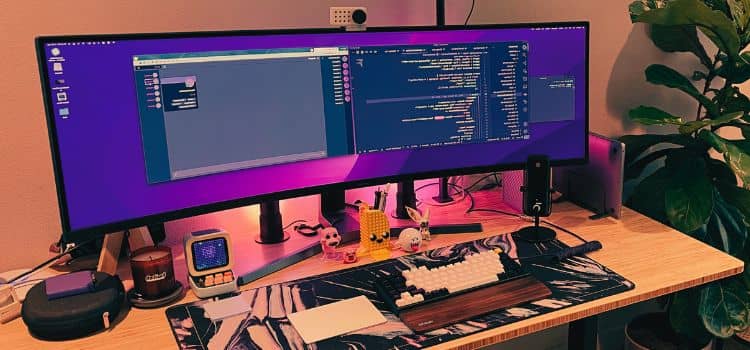
Sit-Stand Desk⤻ͣ
Sitting too much is obviously bad for you. And as programmers, we do it for hours and hours every day. Standing is a bit better–but too much of it isn’t ideal, either.
The best option is a mix of both. A sit-stand desk you can control electrically (or even by crank) lets you switch positions relatively quickly, and puts your body into the varied posture it craves.
Anti-Fatigue Foot mat⤻ͣ
The same goes for your feet. Your feet are made to experience differing surfaces and movement challenges throughout the day–or else they stiffen up, and slowly lose function. When you’re in standing mode, it’s the perfect time to let your feet explore the mini-landscape in the form of a foot mat made for this exact purpose.
Which Hardware to put on your coding desk
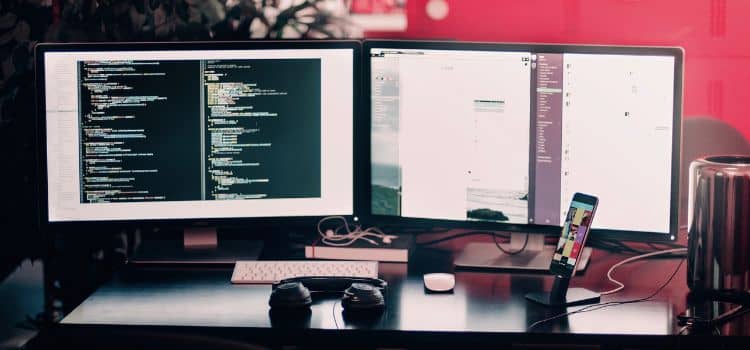
Desktop or Laptop computer for your coding desk?
If possible, go for a desktop for higher performance at lower pricing, and better upgradeability.
On the other hand, if you frequently need to work while you travel, get a laptop instead.
Better optics for your machinery
- A laptop dock⤻ͣ looks sleek for when you’re using it with the lid closed (or simply storing it).
- Adding RGB lighting⤻ͣ to your chassis gives your PC a much cooler look
Desk Shape and Layout
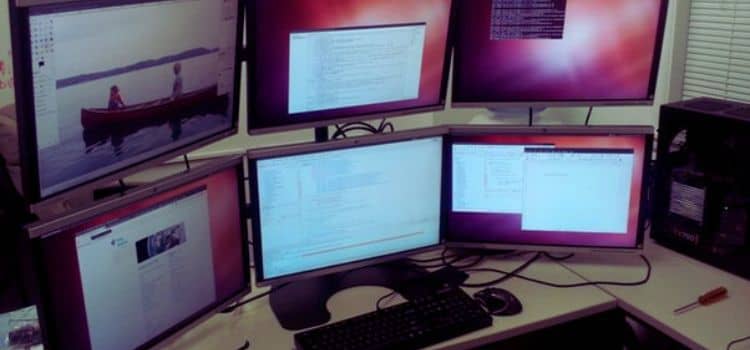
Straight vs corner desks
A corner desk does give you additional space to put things like a printer, for example. But it’s not something that’s strictly necessary for a great programming desk setup–and it can look less slick than a straight desk.
Cutout desks offer better ergonomics
A desk with a cutout makes for a more immersive coding experience. It also gives you more space to rest your forearms and wrists on, which puts you into a healthier position while you’re working. This point is relevant only if you’re not using a keyboard tray under the desk (which is recommended and we’ll get to later).
Laptop Stand (if using a Laptop)⤻ͣ
Keep your coding environment at eye level. This is important to avoid head-forward posture, neck pain and injury. If you’re using a laptop as your main, or as a supplementary screen, make sure to put it up on a dedicated stand. That way you’ll never have to hunch over to work on it.
Monitor Arm to Adjust & Rotate Your Screen(s)⤻ͣ
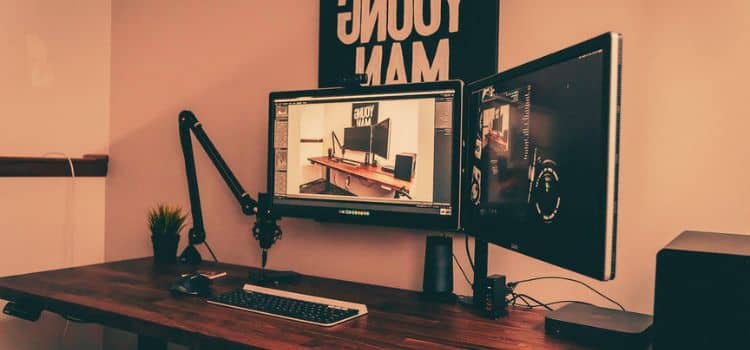
Especially if you’re using twin monitors, it could make sense to mount both of them to one of these versatile monitor arms. They’ll let you freely & quickly change the position of your monitor setup without having to fiddle with each screen’s individual stand.
Because they’re so robust and versatile, they’re a better option than the integrated stands in almost all cases anyway.
Backlighting⤻ͣ
The right lighting helps you get into the right mood for a coding session. It can give your desk setup a really cool look—you can even pick custom-colored lights to design it to your taste even more.
More added benefits of good lighting are that it eases the strain on your eyes, and makes you and your space look better if you’re doing video calls or recording videos to share on YouTube or other platforms.
Keyboard Tray⤻ͣ
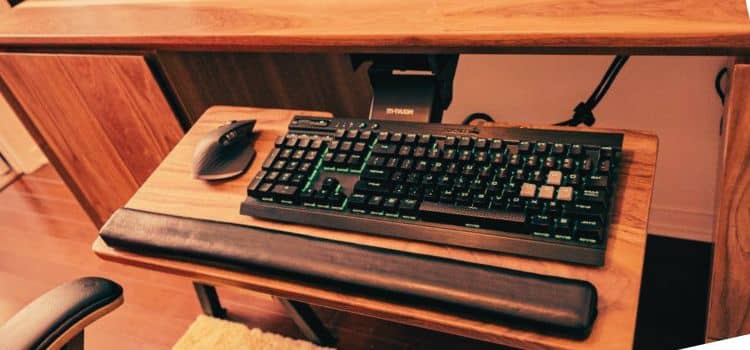
Something most programmers suffer from are tight upper trapezius muscles. They’re the ones pulling up your shoulders towards your ears. The culprit is having to elevate your arms to reach your coding PC’s periphery—because keyboard and mouse are sitting on a desk that’s simply too high.
Do you want to be able to sustain a long programming session (and career) without pain? Then your shoulders need to carry as little tension as possible!
You accomplish this by using a keyboard shelf underneath the desk. Now you’re reaching straight ahead—or slightly down—to type, causing your traps to stay relaxed.
Mechanical, Ergonomic, Split Keyboard⤻ͣ
When you’re using a regular keyboard for coding, your shoulders are constantly rotated inwards. This makes the shoulder and chest tightness caused by working at a desk even worse.
What a split keyboard does is allow you to type in a more neutral shoulder position. Over time, this can make a big difference in your shoulder health and overall posture.
Wrist Rest⤻ͣ
If you rest your wrists on the desk surface – writing code on a keyboard placed on top of it – they will be placed into extension the whole time. Obviously that’s not optimal, and it can even lead to things like Carpal Tunnel Syndrome.
By placing a soft pad under each wrist, you’ll create a neutral position for your wrist. They’ll thank you for taking off the stress.
Programmable Multi-Button Mouse⤻ͣ

With the many repetitive tasks and commands we’re doing as programmers, any way to automate or add efficiency to their execution is more than welcome. This is where a good programmable mouse can come in handy.
For example, if you’re using a tiling software to manage your monitor setup, you could assign buttons for jumping between your different work areas.
Desk Pad⤻ͣ
A big desk pad will turn your hard worktop into the most comfortable and secure surface for your coding periphery. You’ll likely want to have a mouse pad anyway, so why not make it bigger?
That way you’ll get more area for mouse movement, comfort for resting your arms, and anti-slip padding for your keyboard at the same time. Improved optics for your desk space are an added bonus.
Desk Setup Essential for Software Engineers – FHD Webcam⤻ͣ

Because professionally programming work for clients or employers is not simply a solitary affair anymore–like it or not, you’ll need to frequently check in with clients, employers or team members, often by video call–a proper webcam with good lens and resolution is a sensible investment.
Some models offer such high video quality that they’re perfectly suited to record videos for YouTube or other platforms as well.
KVM Switch⤻ͣ
As programmers we often have multiple machines for different purposes. By adding a KVM switch to your desk, you’ll be able to jump between and use the same monitor, mouse and keyboard for all of them.
Noise-Canceling Headphones⤻ͣ
When you need to give full focus to your programming work, you want to block out all outside sounds. Thankfully we have amazing technology today that does it perfectly.
Not only will these headphones improve your efficiency when writing code—you can take them with you whenever you travel, greatly reducing your stress and making any plane ride that much more peaceful.
Professional Chair⤻ͣ
Yes, a great programmer chair represents a mid-sized monetary investment. But it’s one that can save you a lot of back and hip pain down the line.
Unfortunately, humans aren’t built for sitting on our butts for hours on end developing software. The least we can do to limit the damage we’re doing to our bodies is put ourselves into a more ergonomic sitting position. A high-quality chair with back & neck support helps you do that.
Consider spending the money—I promise you’ll be paid back with more productivity and longevity in your programming career.
Footrest⤻ͣ
While we’re sitting there using only our brain and hands, our legs are craving movement—or at least a change in position once in a while. If not, our muscles tighten up, and the legs can even swell up because blood flow is being limited.
Place a simple footrest in front of you under your desk, and you’ll be able to stretch out your legs, move your ankles, and generally sit in a more neutral position. Believe it or not, it even takes some stress off your back.
Speakers⤻ͣ
Sometimes you don’t want to wear your headphones, or you have company. This is why it’s cool to have some good quality speakers at your programming desk as well. It’s nice to have the option to create some ambience audio, or shake the walls with your favorite tunes.
Cable Management⤻ͣ
The perfect programmer desk setup obviously can’t have a mess of cables. You’ll want to have everything clean, organized, with all cables neatly tucked away.
Your work station will look much better and this will unclutter your mind as well, so you can focus even better on your code creation. This is one of the cheaper upgrades to your setup, but which makes a big difference.
Greenery⤻ͣ

Want to turn your work area into a more lively environment? Then consider adding some plants. They’re also good for improving air quality.
Art⤻ͣ
Depending on which style you’re going for with your desk setup, there’s different styles of art you can choose to put on your walls. It’s a perfect way to round out your programmer habitat.
Gadgets⤻ͣ
If you’re into Star Wars, Anime, or any other fantasy characters: Putting little statues or toys will definitely add character to your work desk.
